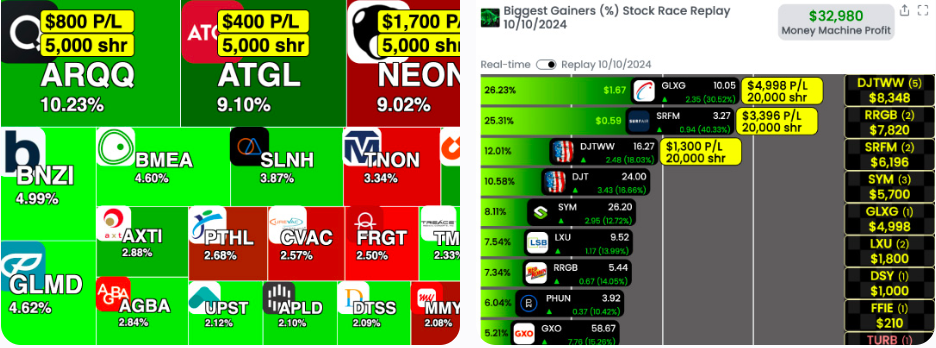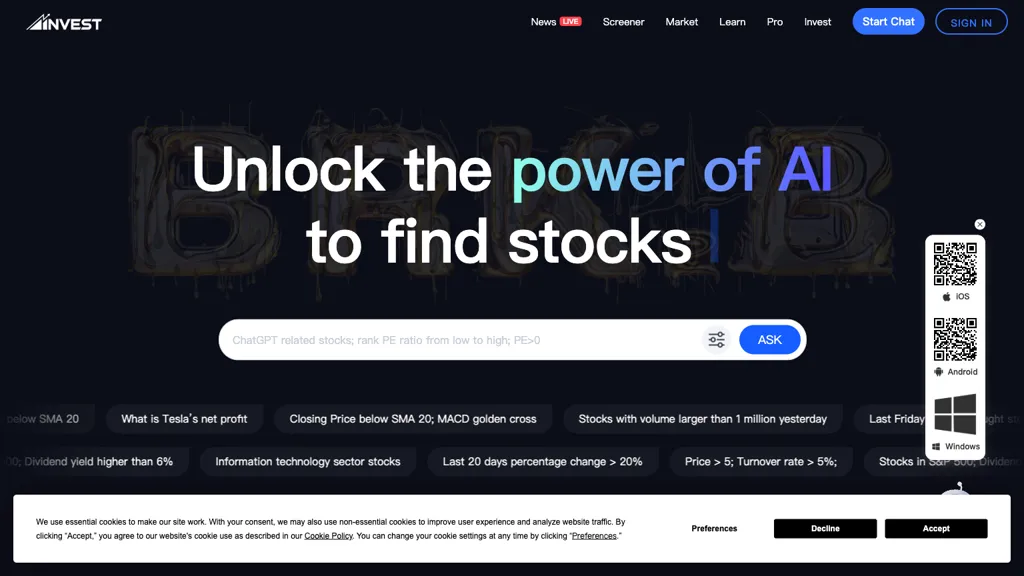20 Great Tips On Choosing AI Stock Investing Analysis Websites
20 Great Tips On Choosing AI Stock Investing Analysis Websites
Blog Article
Top 10 Suggestions On How To Assess The Strategy Customization Of Ai Trading Platforms
It is crucial to remember that AI trading platforms with predictive analysis of stocks are able to offer users the ability to customize their platform according to their goals in trading as well as their risk tolerances and market conditions. A platform that offers flexible options for customization can dramatically increase the effectiveness of trading. Here are 10 top tips to help you evaluate the platform's ability to customize your strategy:
1. Evaluate Pre-Built Strategy Templates
Variety of Templates: Verify whether the platform that you trade on has templates pre-built for different trading styles (e.g. Day Trading or Swing Trading, Long-Term Investment).
Easy to use: Check the ease with which you can apply and alter these templates to suit your requirements.
Performance history: Check if the platform offers historical performance data on pre-built strategy.
2. Assess the Custom Strategy Development
Drag-and-drop: Look for platforms that offer drag-and-drop interfaces to create custom strategies.
Look for options to code. For those who are more advanced, it may be necessary to verify if the service allows custom programming.
Flexibility. Make sure you can define the key elements like the parameters for risk management, entry and exit regulations, and any other elements of your strategy.
3. Check for Backtesting Capabilities
Historical data: Determine whether you have enough facts to back-test your strategies.
Adjustable parameters: Ensure that you can adjust parameters (e.g. timeframes, timeframes, indicators) during backtesting.
Performance metrics - Make sure to see if your platform offers detailed indicators of performance (e.g. the win rate, Sharpe coefficient, or drawdown) for all strategies tested back.
4. Evaluate Real-Time Strategy Testing
Paper trading: Ensure that the platform lets you simulate or test your strategies without risking any capital.
Live testing - See if you can test strategies with tiny amounts to test how they perform.
Real-time Adjustments: Determine if you're able to adjust in real-time, based upon the market conditions.
5. Assess Integration with Technological Indicators
Libraries for indicators: Make sure the platform has a full library of technical tools (e.g. MACD, RSI and moving averages).
Custom indicators It is possible to develop or import your own indicators that you can utilize in your plans.
Indicator combinations: Verify whether the platform permits multiple indicators to create more complicated strategies.
6. Check for Risk Management Tools
Stop-loss/take-profit: Ensure the platform allows you to set stop-loss and take-profit levels within your strategies.
Position sizing. Check whether you have rules in place for the best way to handle the risk (e.g. the amount you set, percent of portfolio).
Risk-reward ratio: Check whether the platform allows setting risk-reward ratios for specific strategies or trades.
7. Evaluate Multi-Asset Strategy Support
Asset classes: Make sure the platform supports strategies across multiple asset classes (e.g. ETFs, stocks, options Forex, ETFs).
Cross-asset strategies : You can make strategies that involve different asset classes (e.g. pair trading, hedges).
Market coverage. Check if the platform covers the markets that you are interested in (e.g. US international, copyright).
8. Evaluate Automation and Execution
Automated trading: Ensure the platform allows automated execution of strategies that follow predetermined rules.
Types of orders - Make sure that the platform can support a variety of order types for execution strategies (e.g. stop market, limit or stop).
Latency: Check that the platform is able to perform trades with minimal latency, particularly when using high-frequency strategies.
9. Make sure you are using tools for strategy optimization.
Parameter optimization - Make sure that the platform includes tools for optimizing the strategy's parameters.
Machine learning integration: Determine whether the platform incorporates machine learning to improve and optimize strategies.
Scenario analysis: Check if the platform allows you to test different strategies in various market situations (e.g. bear, bull volatile).
Review Community Feedback and User Feedback
User feedback: Conduct user research to determine the efficacy of the platform in creating a custom strategies.
Forums for communities: Find out if there is an active community of users who discuss and share strategies.
Support resources: Ensure that the platform offers tutorials, webinars, or documentation to help users create and optimize strategies.
Bonus Tips
Trial period - Use the trial period for free to try out the ability to customize your strategy.
Scalability: Ensure that the platform can cope with increasingly complex strategies in your trading grows.
Support for customers Find out if there's assistance available to address inquiries or concerns relating to strategy.
By following these tips, you can effectively assess the capabilities to customize strategies of AI trading platforms that predict and analyze stocks Be sure to select the right platform that is compatible with your goals in trading and permits you to implement and refine your strategies in a way that is efficient. A platform with powerful customization options will allow you to adapt to changing market conditions and improve your trading performance. Follow the recommended source for ai for trading for site advice including best ai stock trading bot free, trading ai, incite, ai investing app, ai for investment, trading with ai, ai stock, investing ai, ai for stock predictions, ai stocks and more.
Top 10 Tips For Assessing The Transparency Of Ai Stock Predicting Trading Platforms
Transparency is a key factor in evaluating AI-driven trading and stock prediction platforms. It allows users to trust the operations of the platform, understand how decisions are made, and validate the accuracy of predictions. Here are the top 10 tips for assessing the authenticity of these platforms:
1. A clear explanation of AI Models
Tips - Make sure that the platform offers a detailed explanation of the AI algorithms that are used to forecast the future.
What's the reason? Users can be able to better judge the reliability and limitations of a technology by analyzing its technology.
2. Data sources that are disclosed
Tips: Find out if the platform makes public its data sources (e.g. historical stock data or social media).
Why: Knowing the sources of data ensures that the platform uses credible and complete data.
3. Performance Metrics and Backtesting Results
TIP: Look for clear reporting on the performance metrics like the accuracy rate, ROI, and backtesting.
Why: This lets users verify the effectiveness of the platform and its historical performance.
4. Real-time notifications and updates
Tips: Make sure you are receiving real-time alerts and updates on the system's trades, predictions or any changes to the system.
Why? Real-time transparency allows users to be updated on the critical actions.
5. Open Communication About Limitations
Tip - Check to see whether the platform is transparent regarding the risks that come with its trading and forecasting strategies.
Why: Acknowledging limits builds confidence and allows you to make better choices.
6. Raw Data is available to users
Tips: Find out if the AI model can be utilized to gain access to raw data, intermediate results or both.
The reason: Users can conduct their own analysis with raw data, and then verify their conclusions.
7. Transparency in the way fees and charges are disclosed.
Be sure that the platform provides every cost for subscriptions, and any other extra costs.
Why: Transparent pricing prevents cost-insane surprises and helps build trust.
8. Regular Reporting and Audits
Find out whether there are any regular reports from the platform or if an external auditor is able to verify its operation and its performance.
The reason: Independent verification adds credibility and guarantees accountability.
9. Predictions that can be explained
TIP: Check whether the platform explains how it generates specific predictions or suggestions (e.g. decision trees, feature importance).
Explainability is a software that helps users to understand AI-driven decision making.
10. Customer feedback and support channels
Tips. Determine whether there are any channels that can be used for user feedback, support and transparency in response to users' concerns.
Why: Responsive Communication demonstrates an commitment to transparency, and user satisfaction.
Bonus Tip : Regulatory Compliance
Make sure the platform is adhering to the relevant financial regulations and publicly discloses the conformity status. It adds an additional layer of trustworthiness and transparency.
You can assess these aspects to decide if the AI stock trading and prediction platform is transparent, and make an informed decision. This will help you to increase your confidence and confidence in the capabilities of the platform. Check out the best look at this on ai options for more tips including stock predictor, ai options, invest ai, ai stock prediction, free ai stock picker, ai options trading, ai tools for trading, ai options trading, chart analysis ai, ai options trading and more.